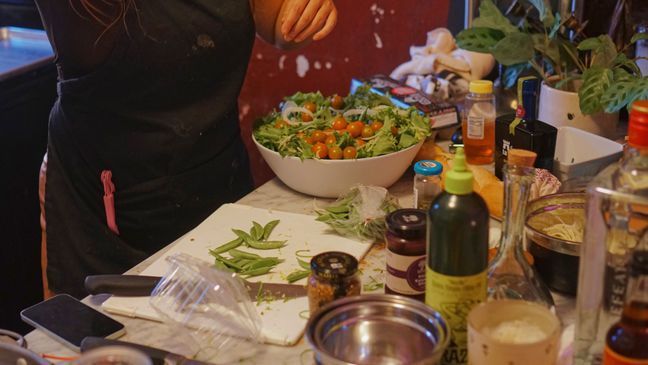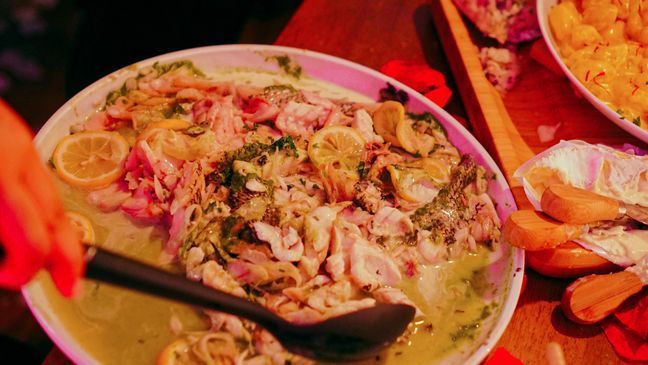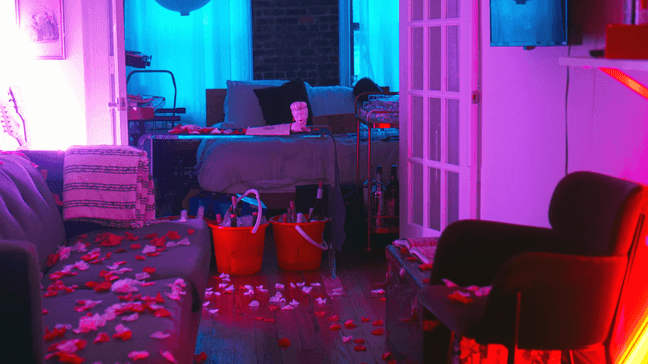Navigating the dinner party trend with social anxiety isn't as scary as it seems
NEW YORK (TND) — In the hours leading up to any sort of gathering, an all-too-familiar sense of unease starts to swirl in the pit of my stomach.
The type of event doesn’t matter — my social anxiety does not discriminate. "A family Easter egg hunt?" my mom will ask somewhat incredulously. Absolutely. A friend’s birthday brunch? You bet. Job interviews? Don’t make me laugh.
One of those trendy new dinner parties that speaks to quite a number of my interests — A multicourse meal dreamt up by an accomplished chef! A beautiful, intimate location outside the norm, probably with a lot of candlelight! A well-curated wine pairing with copious refills! — and promises an evening of meaningful conversation conducive to those deep, authentic connections that don’t usually tend to form over the span of a few hours?
Downright terrifying.
For those who don’t share my social anxiety, try this: Imagine that you have to work up the courage to ring a close friend’s doorbell, and then conjure up the feeling of your armpits sweating profusely in the elevator up to their apartment. Now, same scenario, but it’s a stranger’s apartment, it’s full of people you don’t know, and your heart is positively pounding.
Of course, that same fear-inducing scenario is also presented as a primary reason to choose a dinner party, full of potential new friends, over a reservation at a conventional restaurant with those you already know.
And despite my trepidation, I do get the appeal. So even with my nerves and my armpit sweat and my very strong tendency to cancel plans at the last minute, I let the admittedly intriguing concept lure me to an apartment in Greenpoint, Brooklyn for an evening of the unknown.
Depending who you ask, credit for the dinner party trend goes to: millennials (sometimes), Gen Z (more often), an increased need for community after COVID-19, the reality television series “Overserved with Lisa Vanderbilt,” TikToks of elaborate tablescapes, the rising cost of dining out, the charcuterie board fad, even the obsession with hygge that had everyone chasing the Danish philosophy of coziness a while back.
However the trend began, dinner parties caught on, with two main routes of execution.
The first is, well, a dinner party in the way it’s always been done — friends invite friends to come over for a meal served at their home. The rest is up for the host’s interpretation.
Does it stick to the classic template followed by generations past? Will it be a fairycore-themed gathering with delicate wisps of cotton candy served in a whimsical pastel garden, or should it tap into nostalgia with childhood comfort foods and crayons scattered all over white paper tablecloths? Is it a casual affair with mismatched plates on a Tuesday night? Or is it a modern take on a wedding that cuts the guest list in half to subsequently up the extravagance of each place setting?
How many candles should there be (because every dinner party seems to need an abundance of candles)?
Then, there’s the monetized dinner party, also with candles but now with a cost to attend.
At these events, the ticket price may simply go toward that evening’s groceries, or it could be enough for the host to turn their gatherings into a full-time job. But either way, there will be a ticket. And there will only be so many tickets, and those tickets will likely be in high demand.
Lately, this second type of dinner party has felt nearly as ubiquitous as new restaurant openings.
Directions to my first dinner party took me to a familiar area. The address was just a couple blocks away from the pedestrian ramp to Pulaski Bridge, once a regular part of my morning commute. Certainly, I had passed by the nondescript apartment building time and time again, but I never had any reason to give it much thought.
On the night of the party, my mind was churning with the possibilities of what could be awaiting me inside.
Some information, of course, could be gleaned from the event series’s website and from the Instagram account where I had first stumbled upon Lucky Dinner Club.
Lucky Dinner Club is run by Gabrielle Macafee, who is not a professional chef (“I just love to cook and am pretty good at it,” she writes in the FAQ). It began back in December of 2021, when Macafee welcomed friends into her apartment and made them a traditional Spanish meal. Each of the eight attendees knew only Macafee, but as conversation and wine flowed, the power of good food to bring strangers together was on full display.
The next gathering came a month later in January 2022, then a martini-themed party that February and many more to follow.
With each event, the menu changes depending on Macafee’s recent travels, the best meals she has eaten lately, seasonal produce at the Union Square Greenmarket, and whatever else feels inspiring at any given point in time (an October dinner, with costumes required, was villain-themed, whereas a February event focused on "remedies"). Most have taken place at Macafee’s apartment; a few have ventured off-site to pop-up event spaces, a Soho gallery, and a state park.
Party attendance has grown, though events remain small. Intimacy is a non-negotiable.
A few days before the party, an email from Macafee appeared in my inbox.
In it, she sent the address, an allergy form, and her Venmo, for those who had not yet sent their $40 payment. The menu was left ambiguous, described only as “summery and delightful,” with libations provided. She did reveal the theme: an 1888 painting by Lawrence Alma-Tadema titled “The Roses of Heliogabalus.”
The pink-floral-coated scene depicts a banquet at which Roman emperor Elagabalus supposedly smothered his guests, some to death, under a barrage of rose petals released without warning from a reversible ceiling. There would be no suffocation at Lucky Dinner Club, Macafee promised. There would, however, be death — the total destruction of the meal at the hands of the hungry attendees.
“I suppose this is the theme,” Macafee wrote, referring to Alma-Tadema’s 1888 oil painting. “Dress as if you're heading to some freaky Roman emperor's soiree.”
Macafee’s email was detailed and straightforward. How much more information could I possibly need in order to ease my mind?
A lot, it turns out, especially without being able to text a friend, “Hey, what are you going to wear? How are you interpreting the theme? Are you staying casual, or do you plan to dress up? What time are you planning to get there? Do you think we should bring something? How late do you think it’ll go? When do you think you’ll head home?”
Maybe it was a good exercise for me.
As it turned out, none of those questions had a firm right or wrong answer. But if I had been offered a do-over on my decisions, I would have gladly rewound time.
I didn’t have a clue how to dress for a Roman-Empire-esque evening of debauchery and destruction, so I zoomed in on the woman in the lower right corner, who seemed to have avoided the deadly fate suffered by those next to her. The texture of her short-sleeved seafoam green dress reminded me of lace, so I pulled out a frilly yellow dress that I once wore for Easter Mass, forgetting that there had been any mention of debauchery on the invitation.
There was also the 7:30 p.m. start time, which, in the context of a dinner, didn’t seem particularly ambiguous. I pictured myself showing up late only to realize that not only was every single chair already taken but every single guest was already wrapped up in intensely personal conversations that could only be joined with a real sense of intrusion.
Instead, I wound up as the first to arrive, only marginally better than the nightmarish scenario I had dreamt up. If only I had seen the Instagram post recapping a Lucky Dinner Club event one year earlier. In the caption, Macafee referred to the dinner as “a house party with good food,” and everyone knows you don’t arrive on time to a house party.
Lucky Dinner Club didn’t cure my social anxiety. (Wouldn’t that be something if it did?)
But it did have every element Macafee promised. There was good food, and plenty of it: to start, an enormous charcuterie board with a cheese for every taste and a salad large enough to feed a village with perfectly in-season tomatoes, then mussels and fish and gnocchi and too many cakes for two dozen people, even when all two dozen are indulging for the sake of decadence and destruction. There was wine, and far too much of that too, but no one was complaining. There were places to sit and places to stand and people ready to talk to you wherever you landed and conversations that went beyond small talk.
Toward the end of the evening, we played the dinner party’s namesake game, involving a deck of cards and dice with a bottle of wine awarded to the lucky winner. I didn't win, but I went home satisfied. Drained, but satisfied.
Maybe, with enough dinner parties, the ratio of drained to satisfied will start to shift. Maybe it'll feel easier to overcome social anxiety, and the massive knot in the stomach will become smaller, and the palms will get less sweaty. Exposure therapy, if you will.
For socially anxious New Yorkers, Lucky Dinner Club — where no one judged me for my early arrival or for my Catholic-Mass-appropriate yellow dress in a more monochromatic sea of far cooler outfits — is a good place to start.
Macafee emphasizes her efforts to create a safe and inclusive space. The environment is intentionally relaxed. She’s not big on time-consuming tablescapes that distract from the true ethos of her event series. By the end of every event, she is sweaty and exhausted; she can't be bothered with aesthetics.
It's the combination of high demand and limited capacity, not an attempt at exclusivity, that keeps hopefuls from having the opportunity to experience Macafee's often sold-out Lucky Dinner Club.
There's some luck involved when it comes to the timing of ticket releases, but signing up for the newsletter will increase your chances. Events are released first to subscribers, and then posted on Instagram later on.
But it doesn’t have to be Lucky Dinner Club, and it doesn’t have to be in New York City. Take comfort in the proliferation of dinner parties these days, and then take time to find one that will best align with your values, expectations, and taste buds.
“There are some supper clubs that are more reservation-based, and it’s more like a pop-up,” said Tatiana Ettensberger, wine director of the Los Angeles-based Seconds Supper Club.
“We were considering that for a bit,” she continued, “but we love the idea of this super, super long table where you’re sort of forced to meet someone new and maybe flirt with someone and cross forks.”
That’s also why the four founders of Seconds Supper Club settled on family-style dining, in hopes that the polite passing of plates would become a natural start to a deeper interaction. And it’s working — since the event series’s launch in early 2023, countless connections have been forged.
Ettensberger’s favorite story so far? Two women bonded so quickly over the course of the dinner that they ended up having an old-fashioned sleepover, complete with sheet masks, that same evening.
Last month, I attended a pop-up dinner at a Bushwick production space hosted by chef Mimi Gharib. I brought my partner along, thinking her presence would significantly reduce my social anxiety. We walked in together, we introduced ourselves together, and we sipped on mezcal together.
Then, in a fleeting moment of alarm, we realized our place cards were situated catty-corner from one another with a massive moss centerpiece and floral arrangements partially obstructing our view of each other’s faces. As guests slowly made their way to the table, we tried to guess, based on name alone, which of our fellow diners would eventually end up in the empty seats.
Panic aside, our positioning did make sense.
It became clear early on that my partner and I were the only two attendees without a close connection to the chef. Blending us into the group, with some force, eliminated any potential for isolation.
A gentle push into the conversation was indeed helpful, as were the conversation starter cards strewn about the table. I found out no one seated at my end of the table believed in soulmates, and I got wrapped up in a lengthy conversation about synesthesia that was far more interesting than the usual small talk centered around careers and the weather.
Nonetheless, I was glad to have my partner to make eye contact with across the moss.
Like the feast that Macafee so lovingly crafted in her own kitchen, the five-course meal that Gharib prepared — partially in the dark during an unexpected power outage — was nothing short of a masterpiece.
The cheesecake, in particular, blew me away by subverting every expectation I could have possibly had about cheesecake to the extent that I have since found the dessert impossible to properly describe, though not for lack of trying. It was made with lemon sorbet, gingerbread cardamom meringue, and some kind of wizardry that’s perhaps powerful enough to flicker the lights. If you get a chance to try it, let there be not a moment’s hesitation.
Despite the dread I tend to feel prior to stepping into any socially-oriented space, and especially into one filled with strangers, I’m looking out for my next dinner party. Maybe good food — really excellent food, in fact, that seems to exist only as a byproduct of a chef working within the boundaries of a dinner party’s unconventional environment — is what I’ve always needed to one day conquer a lifelong fear.




